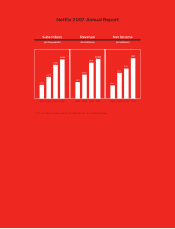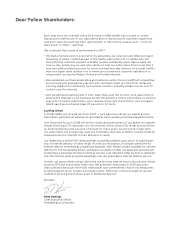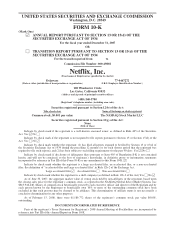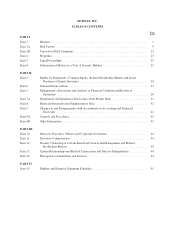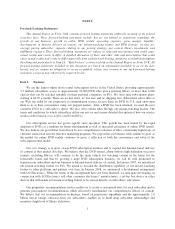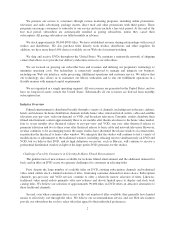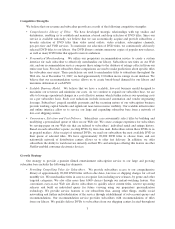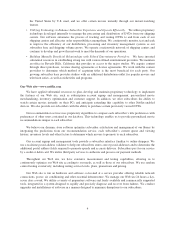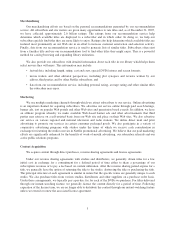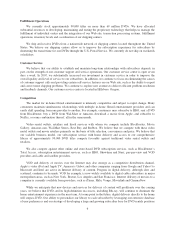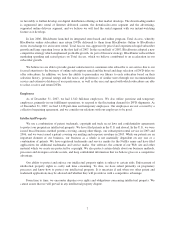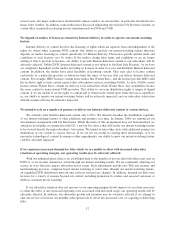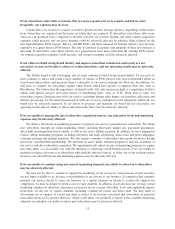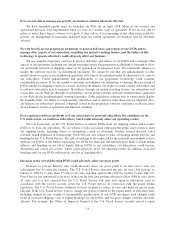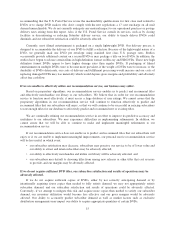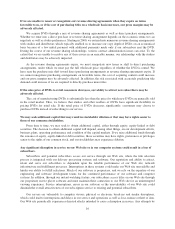NetFlix 2007 Annual Report Download - page 12
Download and view the complete annual report
Please find page 12 of the 2007 NetFlix annual report below. You can navigate through the pages in the report by either clicking on the pages listed below, or by using the keyword search tool below to find specific information within the annual report.us favorably to further develop our digital distribution offering as that market develops. The downloading market
is segmented into rental of Internet delivered content, the download-to-own segment and the advertising-
supported online delivery segment, and we believe we will lead the rental segment with our instant-watching
feature as it develops.
In late 2006, Blockbuster launched its integrated store-based and online program, Total Access, whereby
Blockbuster online subscribers may return DVDs delivered to them from Blockbuster Online to Blockbuster
stores in exchange for an in-store rental. Total Access was aggressively priced and experienced rapid subscriber
growth and large operating losses in the first half of 2007. In the second half of 2007, Blockbuster adopted a new
competitive strategy which emphasized profitable growth. As part of this new strategy, Blockbuster reduced their
marketing spending and raised prices on Total Access, which we believe contributed to an acceleration in our
subscriber growth.
We believe we are able to provide greater satisfaction for consumers who subscribe to our service due to our
focused attention to the business of online subscription rental and the broad and deep selection of DVD titles we
offer subscribers. In addition, we have the ability to personalize our library to each subscriber based on their
selection history, personal ratings and the tastes and preferences of similar users through our recommendation
service and extensive database of user preferences, as well as the ease and speed with which subscribers are able
to select, receive and return DVDs.
Employees
As of December 31, 2007, we had 1,542 full-time employees. We also utilize part-time and temporary
employees, primarily in our fulfillment operations, to respond to the fluctuating demand for DVD shipments. As
of December 31, 2007, we had 1,128 part-time and temporary employees. Our employees are not covered by a
collective bargaining agreement, and we consider our relations with our employees to be good.
Intellectual Property
We use a combination of patent, trademark, copyright and trade secret laws and confidentiality agreements
to protect our proprietary intellectual property. We have filed patents in the U.S. and abroad. In the U.S., we were
issued broad business method patents covering, among other things, our subscription rental service in 2003 and
2006, and we were issued a patent covering our mailing and response envelope in 2005. While our patents are an
important element of our business, our business as a whole is not materially dependent on any one or a
combination of patents. We have registered trademarks and service marks for the Netflix name and have filed
applications for additional trademarks and service marks. Our software, the content of our Web site and other
material which we create are protected by copyright. We also protect certain details about our business methods,
processes and strategies as trade secrets, and keep confidential information that we believe gives us a competitive
advantage.
Our ability to protect and enforce our intellectual property rights is subject to certain risks. Enforcement of
intellectual property rights is costly and time consuming. To date, we have relied primarily on proprietary
processes and know-how to protect our intellectual property. It is uncertain if and when our other patent and
trademark applications may be allowed and whether they will provide us with a competitive advantage.
From time to time, we encounter disputes over rights and obligations concerning intellectual property. We
cannot assure that we will prevail in any intellectual property dispute.
7


